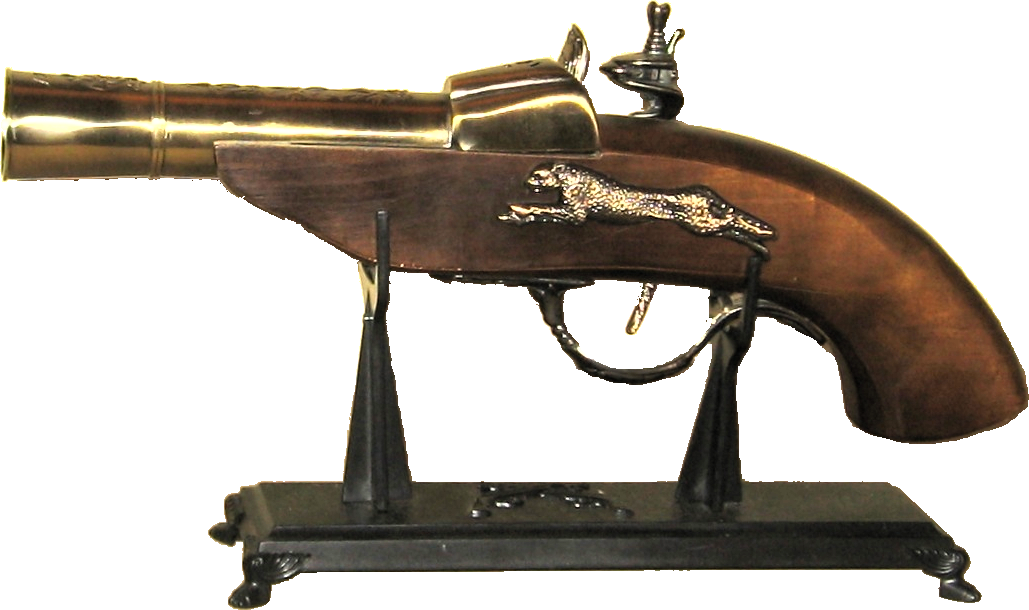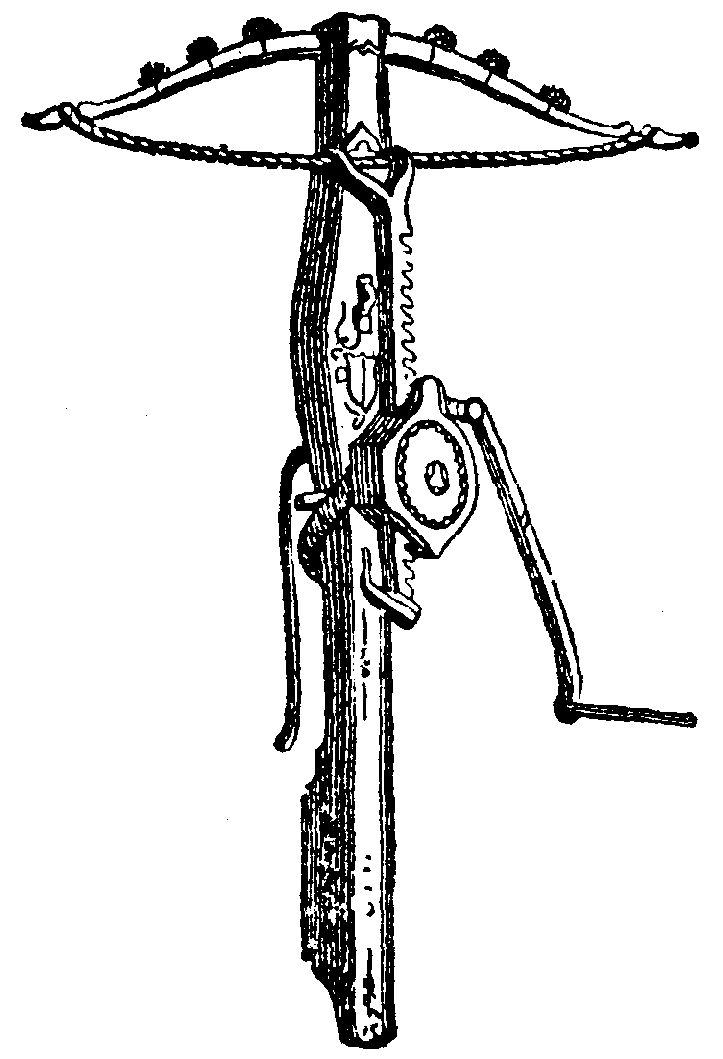Weapons: Firearms

The hand gun and arquebus are two-handed weapons, as is any matchlock-style firearm. A wheel-lock firearm could be used one-handed, although rifle-sized weapons would still require two hands to steady. Firearms require a supply of gunpowder, which must be kept dry. Early firearms also require a match to light the gunpowder, and matchlocks have this match built in. The match must also be kept dry.
Gunpowder: Gunpowder is a powdered, explosive mixture of 75% sulfur, 15% charcoal, and 10% saltpeter. Sulfur is found as brimstone in volcanic areas, or mined from underground deposits. Saltpeter is usually recovered from urine and manure, in a time-consuming and unpleasant manner. The best charcoal comes from softwoods such as willow, soft pine, redwood, and cedar. Each ingredient must be powdered separately: grinding them together is a mistake usually not made twice. When dry, gunpowder is easily set off even by the friction of grinding.
Hand Gun: The simplest form of firearm and the earliest, these firearms were tubes with a handle, and required that the powder be lit through a touchhole with a lit match cord also held in the hand. The rate of fire of a hand gun could be increased to once per three rounds with the use of an assistant.
Arquebus: While it eventually came to mean a gun of fine workmanship, originally the arquebus was simply a heavy matchlock. The Arquebus was first heard of in the late fourteenth century, but were more common in the seventeenth century. The “matchlock” style of firearm continued to use a match cord to light the powder, but the cord was attached to a mechanism which could lower the lit match to the pan to light the powder. With an assistant to refill the pan and reload, the arquebus rate of fire can be increased to once per two rounds. The Arquebus tends to be about the size of what is today a rifle, although the barrels were not rifled and were thus not nearly as accurate.
Wheel Lock: A “wheel lock” firearm uses flint or pyrite which rubs against a rough-edged wheel to create a spark to light the gunpowder in the pan. The wheel lock pistol was generally about eighteen inches to two feet long and could be fired with one hand, though more accurately than the hand gun.
Match Cord: Early firearms required that their powder be lit by a match in the pan. The match cord would be made of slow-burning material and could be carried in the hat or from the belt. Care must be taken to keep the match dry in moist or rainy weather.
Match Pipe: Those who carried firearms which required a burning match would also often carry a “tube” or “pipe” in which to carry the burning match. The box would be about a foot long, pierced with holes, and designed in such a way that the lighted matches would not betray the whereabouts of the bearer.
Weapons: Crossbow

Where the longbow was the weapon of the yeomanry, the crossbow could be used by anyone. Much like the firearm today, it leveled the military playing field between commoner and knight or other trained soldier. The larger crossbows were more powerful than the longbow, although (at least for hand-carried crossbows) the arrow (called a “bolt” or “quarrel”) was much shorter and did not have the range of the longbow. Crossbows also could not be fired as rapidly. Lighter crossbows had to be pulled back and locked by hand, then aimed and fired. Larger crossbows had to be pulled back by foot as well as hand, using a special stirrup attached to the front of the crossbow. Crossbows were more difficult than bows to protect from dampness as well.
Crossbows were developed throughout the world, from Europe to China and Japan, to Africa, Burma, and even the Pacific islands.
One advantage of crossbows is that they are easy to use as unmanned traps. Also, an assistant can double the rate of fire of a normal or heavy crossbow if the assistant is also skilled in the crossbow’s use and two crossbows are available, by readying one crossbow while the shooter is firing the other.
Martial Arts
Martial Arts are any form of unarmed combat requiring heavy training with a bit of mystique added in. Kung fu, Karate, Ju-Jitsu, and Tai Chi are classic Asian examples. African Capoeira is a perhaps less well-known example.
Attacks with Martial Arts are handled as any other weapon attack. Strength bonuses apply. Damage is d4.
Weapons: Spear
The spear is one of the earliest bladed weapons. At its simplest, it is a blade attached to a long shaft of wood. Spears tend to be eight to ten feet long, although they may be as short as six feet and as long as twelve feet. Spears can be used in melee combat and as a thrown weapon.
Spears do not offer as much opportunity for ornamentation as swords, but both blades and shaft have been known to be embellished. The blade is most commonly metal, but can be bone, stone, or shell.
The javelin is a smaller form of spear, about four feet long, and lighter to carry. One of the more useful features of the javelin (although outside of game rules) was its tendency to stick to an enemy’s shield, making the shield too difficult to use.
Weapons: Sword
The sword is the quintessential arm. Until the invention of the firearm, “sword” was the word that meant “powerful weapon”, and still appears in many of our sayings. “The pen is mightier than the sword.” “Lay down your sword and follow me.” The sword’s victory as penultimate weapon comes from its relative ease of carry, relative ease of use, effectiveness, and the fact that it can be made to look cool.
While the ‘sword’ is a fairly generic bladed weapon with no clear delineation from knives on one end and glaive on the other, for our game purposes there are three kinds of swords: the ‘long sword’, the ‘short sword’, and the ‘great sword’. These swords are designed both for cutting and for thrusting. They are double-edged. The great sword, due to its bulk, usually requires two hands to use effectively.
The blade of a long sword ranges from about three feet to four feet. The short sword is about two to three feet long (any shorter is a dagger). The short sword (gladius) was used with devastating effectiveness by the Roman armies.
The scimitar is a variation that is curved, with a single edge. The blade ranges from 30 to 40 inches and is designed mostly for cutting.

